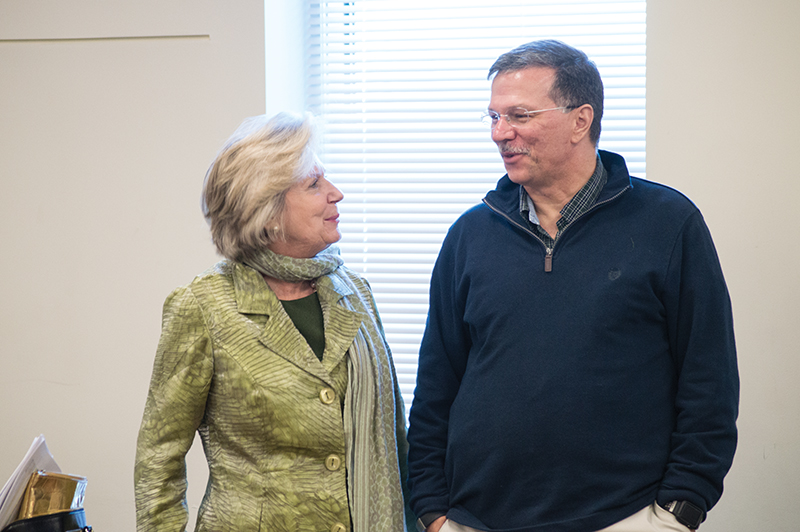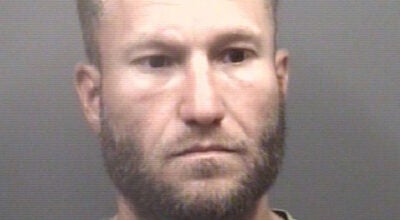Police chief: Gangs cause for most Salisbury gun violence
Published 12:05 am Saturday, March 25, 2017

- Salisbury Mayor Karen Alexander talks to Police Chief Jerry Stokes following a planning retreat in March 2017.
By Josh Bergeron
josh.bergeron@salisburypost.com
SALISBURY — Crime problems in the city limits are homegrown and gang-related, Police Chief Jerry Stokes told City Council members this week.
During a detailed presentation about the Police Department, Stokes talked about gangs in Salisbury, budget requests and a number of other topics. At one point, Stokes provided council members with a map showing the general areas of operation for gangs in Salisbury.
Stokes began his presentation by using FBI statistics to compare Salisbury’s crime rate to that in other cities and prior years.
He selected a number of nearby cities and created a chart showing that violent crime per capita in Salisbury ranked higher than in all but Shelby, Spencer and Winston-Salem in 2014. He qualified Spencer’s violent crime rate by noting it is smaller than other cities on the list. In 2015, only Shelby’s violent crime per capita topped Salisbury’s.
Murders doubled in 2016 over the two prior years, Stokes’ presentation showed. The violent crime rate, however, was roughly the same as in the two prior years.
Stokes said local police officers cannot focus on issues such as traffic enforcement as much because of the crime problems faced by Salisbury.
“We want to focus on people who are violent offenders in neighborhoods, people dealing drugs that are causing problems in neighborhoods,” Stokes said. “Whereas, a community that might not have the same prevalent issues as we see here, an officer would focus their enforcement in other directions.”
A lot of the gun violence here stems from gang activity, he said. In some cases, crime problems begin when there’s a “vacuum of power” after police arrest a high-ranking gang member, he said.
In Salisbury, it’s difficult to determine an exact number of gang members, Stokes said. However, he said local groups or subsidiaries of the Blood Gang — West Side, Puzo, BBA, 9-trey and Gangster Bloods — are the largest. He said West Side Bloods don’t affiliate with or recognize the East Coast BBAs, 9-treys or Gangster Bloods.
A map shown by Stokes showed that West Side Bloods or Puzos generally operate in a square-shaped area that begins at the intersection of Fulton and West Innes streets and moves west. The area of operation for the West Side Bloods and Puzos includes the West End community.
The BBA, 9-trey and Gangster Bloods mostly operate in an area near the intersection of Long and East Innes streets and stretching northeast, past Mahaley Avenue to include Salisbury Country Club.
Crips are the second-largest gang, Stokes said. Local subsidiaries or sets of Crips include Kitchen, 8-tre, Grape Street and Watts. Stokes said SUR 13 or Sureños mostly operate outside the city and are sometimes found with Crips.
Stokes’ gang map shows the Crips generally operate in an area starting at Fulton Street and extending south, past Interstate 85 and to the city limits.
Around East Spencer, Stokes said, there’s a local group that appears to mostly be a hometown claim more than a gang. It’s known as Swamp Life.
Salisbury’s gangs function like organized businesses with areas of operation, Stokes said.
“If you’re my age, you kind of grew up hearing about Los Angeles gangs, neighborhood issues and if you cross this street you’ll get shot,” Stokes said. “You don’t really see that per se of thing here. Just because there’s a line here, you see they intersect and overlap, and somebody crosses doesn’t necessarily mean it’s a disrespect and there will be retaliation. It’s more about business.”
There’s not a conflict over who owns what street as much as interference with various drug operations, Stokes said.
Asked later about the source of the gang issues, Stokes said he might have been inclined to say Salisbury’s proximity to Charlotte is the cause when he first took the job as police chief. After several months on the job, Stokes said, that’s clearly not the case.
“It just seems to be very homegrown,” he said. “It’s very much that this is their home. This is where they operate and do their business.”
City Council member Kenny Hardin used a metaphor to describe the multifaceted problem facing Salisbury. Even if law enforcement takes out some high-ranking gang members, Hardin said, there’s an unlimited number of people waiting to take-higher ranking positions within local gangs.
“If we’ve got a pipe that’s leaking, we can keep putting a glass up under it to catch the water, but eventually we’ve got to stop the leak,” Hardin said.
Project SAFE Neighborhoods could be one solution to solve the leak described by Hardin, Stokes said. The program uses federal, state and local resources to identify people involved in violent crimes and help them through a “structured community intervention.”
In his budget plan, Stokes has requested $50,000 to help pay for a Project SAFE coordinator position. Rowan County would share costs, according to Stokes’ budget proposal. Councilwoman Maggie Blackwell said former City Manager David Treme cut the coordinator position in 2008. It was originally funded by a grant. Later, the city picked up costs for the coordinator position.
Other funding requests from Stokes include $42,400 to increase the number of body cameras at the Salisbury Police Department, $27,542 for new tasers and $40,000 to help start a citywide security camera system.
The total increase requested by Stokes is $948,911. The recommended amount is $748,524. That doesn’t include a proposed $624,250 for police officer raises.
Contact reporter Josh Bergeron at 704-797-4246.


